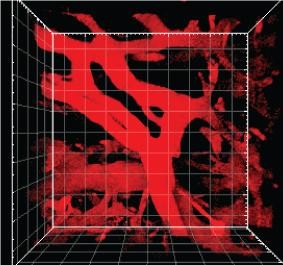Two-step approach to improve pancreatic cancer survival rate

Only 7% of patients with pancreatic cancer survive more than five years after standard chemotherapy. This dismal survival rate hasn’t changed in 40 years of research but has been targeted by pancreatic researchers worldwide, with a goal to double the survival statistics by 2020.
Dr Paul Timpson of the Garvan Institute of Medical Research has co-led a study which aimed to prove “a heated and longstanding controversy in cancer research”, that by softening the tissues surrounding pancreatic tumours, they can increase the effectiveness of the standard chemotherapy.
Using an off-patent stroke medicine, Fasudil, Dr Timpson’s team found that by first tenderising the stromal architecture surrounding the tumour, they were able to create an environment where pancreatic tumours are more susceptible to the standard-of-care chemotherapy.
“We’ve been able to show for the first time that it’s crucial to treat the stroma first and the tumour second, and to fine-tune the treatment timing to maximise outcome, while minimising side effects.”
By priming tumours with Fasudil, the Garvan team doubled survival time in laboratory mice and found an additional benefit of reducing the spread of cancer to surrounding organs.
Dr Marina Pajic co-led the study: “We saw the stroma weaken over time, and could also see that cancer cells did not spread so readily to secondary sites such as the liver.”
Solid tumours, such as those found in the pancreas, are surrounded by the stroma, a complex structure of blood vessels and other tissues which facilitate the growth of the tumour itself and inhibit the delivery of chemotherapy. Fasudil softens the stromal architecture by inhibiting the protein ROCK, making the surrounding blood vessels ‘leaky’ and more easily penetrated by the chemotherapy.
“We also looked over time at the blood vessels supplying the tumour, using fluorescent quantum dots in the bloodstream. It was remarkable to watch the quantum dots radiate out from blood vessels adjacent to the tumours after Fasudil treatment — which is an indicator that the vessels have become leaky.”
The Garvan team were able to see the progress by use of cutting-edge intravital microscopy techniques, which allow them to look inside a living animal, in real time. They were also able to develop an automated analysis of tumour tissue to determine which patients are more likely to respond favourably to this sequential priming therapy, using patient tumour samples from the Australian Pancreatic Cancer Genome Initiative.
According to Dr Timpson: “What we’re seeing is that the therapy works best for tumours with large amounts of surrounding stroma and tumours with a high density of surrounding blood vessels.”
Drs Pajic and Timpson are planning an early-stage clinical study in conjunction with The Kinghorn Cancer Centre at Sydney’s St Vincent’s Hospital, and are hopeful that this new ‘priming therapy’ will also prove effective in treating other solid tumours.
This research was published in Science Translational Medicine and received support from the Avner Pancreatic Cancer Foundation, NHMRC, Cancer Australia, Cancer Council NSW, Cancer Institute NSW and Tour de Cure.
Towards the next generation of vision implants
An ultrasmall implant, with electrodes the size of a single neuron that can remain intact in the...
One-two punch treatment knocks out acute myeloid leukaemia
Researchers paired venetoclax, a current standard-of-care anticancer drug for acute myeloid...
Researchers find the 'switch' that deactivates brown fat
Researchers have found a protein that is responsible for turning off brown fat activity, in a...







